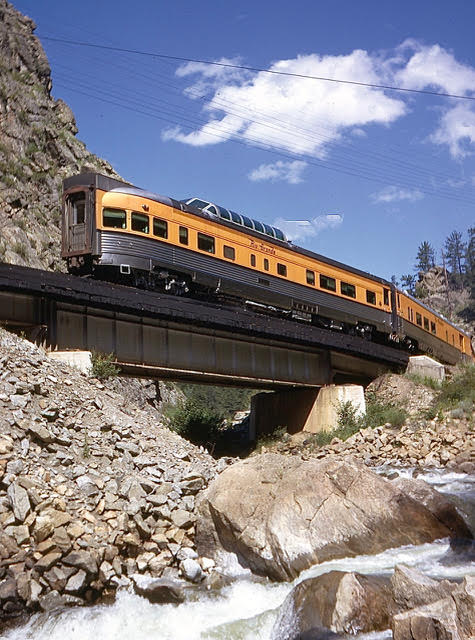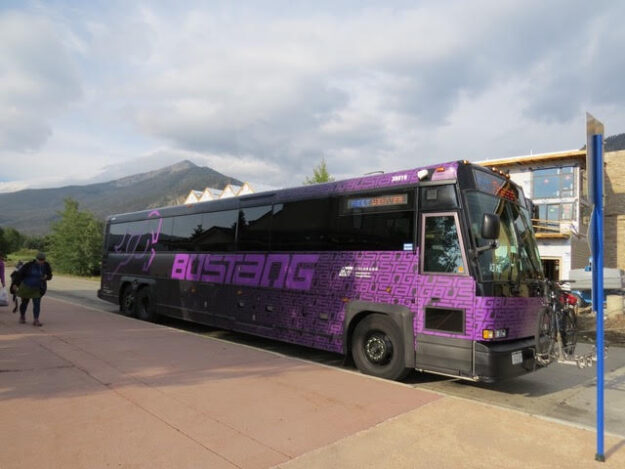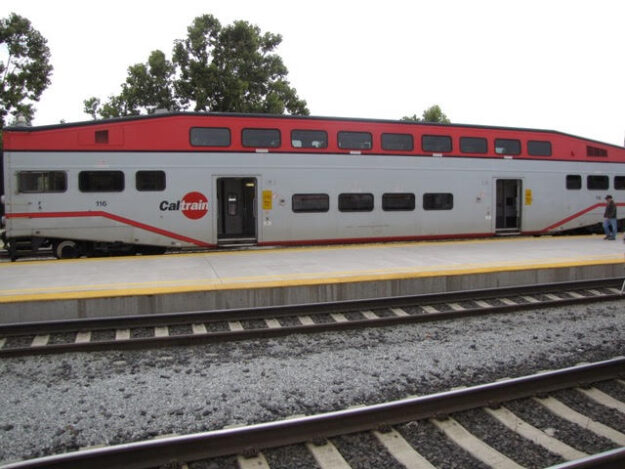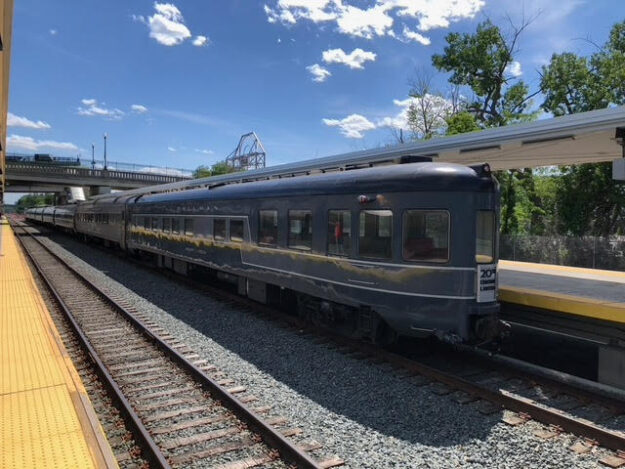Widgetized Section
Go to Admin » Appearance » Widgets » and move Gabfire Widget: Social into that MastheadOverlay zone
Opinion: Realizing Mountain Rail’s full potential in Colorado
Passenger rail in Colorado has been in the headlines recently, primarily focusing on the state’s two most traveled population and economic corridors: (1) Starting new rail services along the state’s most populated north/south Front Range Corridor and (2) Adding to existing rail services along the always problematic east/west Mountain Corridor. The Mountain Corridor is a much simpler opportunity and far less of a challenge. It can be launched in piecemeal fashion in a very short time frame and at a much lower cost. It enjoys enthusiastic gubernatorial and regional support. The following opinion column enumerates suggestions to make a good idea even better – more productive, more expansive, and more successful.
Background
In ColoRail Passenger Issue #76 (at ColoRail.org), in late 2014, an idea was put forth advocating for the return of the Denver-Winter Park Ski Train, last operated in 2009, to be operated by Amtrak. Surprisingly, the idea gained traction and became an Amtrak reality called the Winter Park Express (WPE). Over the ensuing years the service expanded its days of operation from 2 to 5 per week, in gradual fashion, with the 2025 ski season showing the biggest leap yet – an extension to Fraser, an extended season, and greatly reduced fares. This is the “Building Block” strategy, building service levels incrementally upon the success of the previous “Block,” further proving the concept.
The next “Block” promises to eclipse all that came before. Currently dubbed Mountain Rail, and enthusiastically promoted by Governor Polis and others, the proposed train would restore passenger service between Denver, Steamboat Springs, and Craig. Originally named theYampa Valley, the service had ended on that route in April, 1968, due to very low patronage. It is hoped that growth of the Steamboat Resort and growing frustration with the highway mode will warrant return of passenger rail to the region. An ongoing study is evaluating the premise and has been releasing results.

Typical Yampa Valley train equipment near the end of service. Keith Kirby photo
So far, the study has publicly suggested that a Phase 1 operation could commence within 2 years, perhaps even late 2026, between Denver and Granby, one stop beyond the new terminus of the WPE at Fraser, due to the existence of Amtrak stations already in place along the route. Little new infrastructure would be needed to launch a daily service year round, not unlike the ultra low cost of initiating the WPE. However, rail cars and maintenance facilities would still be a sizable expense. Later phases will require more time and funding for rail line upgrades, stations, and other necessities to reach Steamboat and Craig.
Will the new Mountain Rail train service go to the most optimal location?
However, terminating Phase 1 service at Granby leaves large, more productive market segments to the west untapped. And will a Granby terminus, or even farther to Kremmling, generate sufficient ridership year round to justify the rail service Unfortunately, the study is prohibited from examining the potential of continuing the Phase 1 trains to Glenwood Springs (GSC) and Grand Junction (GJT) – two major destinations along the main line used by Amtrak’s California Zephyr – where stations and strong markets already exist. (The Craig Branch departs from the mainline across the state at Bond, CO, 25 miles west of Kremmling.)
It must be noted that the population base along the Grand Junction route is multiple times that of the Craig Branch, perhaps by 400%, and can be greatly amplified by including dedicated connecting buses, extending the reach of the rails to the main I-70 Corridor – the most problematic highway in the state due to terrain, weather, trucks, crashes, and closures. Restoring former train stops at Kremmling and Bond would allow convenient bus connections via State Highways 9 and 131, respectively, to virtually all of the major destinations along I-70 not served directly by rail, further outstripping the Craig Branch’s destinations.
Perhaps a rail alternative serving GSC & GJT should be the destination of Phase 1, with the Craig Branch coming on line when the necessary improvements are completed a few years later. Very few infrastructure improvements would be needed along the main line other than restored station sites. Not extending Phase 1 service to Glenwood Springs and Grand Junction would be a significant missed opportunity.
A further comparison of the two diverging rail lines’ market potential is revealed by comparing the Bustang West Line bus service frequencies. There are about 15 roundtrips per day between Denver and Glenwood Springs, with about half extending to GJT. There is only 1 Bustang Outrider roundtrip to Steamboat and Craig, though it is funded from a separate source. And it leaves Denver at 3:15 PM, with no morning service westbound. Does that not indicate a stronger east/west market, than the north market to Craig? By a 15 to 1 ratio?

Bustang West Line stop in Frisco.
The rapid success and service level increases on Bustang’s West Line between Denver and GJT prove the strength of the east/west market as well as interest in a non-driving alternative, despite the buses being subject to those same numerous highway delays and closures. An extended rail alternative to GJT would further enhance the east/west movement of people, long-frustrated by I-70 and its almost daily mishaps and challenges, especially through the trouble-prone Glenwood Canyon and over the ever-challenging Vail Pass. [As this is being written, I-70 is closed due to two big rigs colliding WB and spilling down into the EB lanes and crashing into other vehicles. This will be a long closure. Just another day on I-70.]
Another relevant factor is that the Amtrak Denver-Glenwood Springs city pair is the 9th busiest nationwide, and the busiest city pair nationally, involving a small city, according to CDOT’s 2024 Rail Plan. How might additional rail service in that market contribute to the trains’ ridership numbers and the local economy? Especially the local economies……
This does not suggest trains shouldn’t go to Craig, but should Craig be the first and only Mountain Rail route considered? Actually, comparing the two route opportunities should not be an “either/or” posture, but one that includes “both.” They should operate in complementary fashion. Perhaps operating as one train to the Bond junction point, where they could separate, saving a valuable time slot through the constricted Moffat Tunnel, with its limited capacity.
There really is a sense of urgency in creating an alternative to the severely compromised I-70. Too much time has elapsed already with decades of million dollar I-70 studies that yielded nothing, except, perhaps, an almost billion dollar realignment of I-70’s Floyd Hill that will only relocate the highway chokepoint to another location.
Finally, one could argue that the Zephyr already serves the east/west market. That’s true, but the schedule reliability of the Zephyr is rather dismal, often due to events that occur beyond Colorado’s borders. And the scheduled times offer only one option in either direction, likely not convenient for many travelers. Further, the Zephyr’s capacity is very limited because most passengers are traveling longer distances, often beyond Colorado’s borders. And the fares can vary considerably, often excessively so, based on load factors.
Service possibilities and Rolling Stock
Colorado deserves its own intrastate mountain rail service with at least 2 roundtrips per day and augmented by Bustang bus service to fill out a full day of convenient times. And rolling stock should be suitable for self-serve handling of skis, bikes, and other recreational gear and luggage. The former Bombardier (now Alstom) multi-level commuter cars are well-adapted to this service standard, provided they receive upgraded seating and amenities. Conventional locomotive-hauled trains provide the flexibility to add and subtract cars as demand dictates. They also would permit privately-owned cars to be added for additional revenue opportunities and service level enhancements, discussed later.
How Mountain Rail will be integrated with the seasonal WPE will have to be determined due to limited time slots through the Moffat Tunnel. And Amtrak’s potential role in the service must also be determined since the national carrier already services the corridor with its famous California Zephyr and the seasonal WPE. Would Mountain Rail replace the WPE, especially if Amtrak were the chosen operator of Mountain Rail, despite Union Pacific’s preferences to be otherwise?

Bombardier (Alstom) commuter car. Two wide doors, low level entry.
Sustainability and Opportunities
Operating passenger trains is an expensive proposition. Volume is key to success, meaning large numbers of passengers are required for a sustainable service. To attract riders, fares must be quite reasonable, especially for traveling families, further pinching the bottom line. Adding more stops and extending Phase 1 operations to GJT will most certainly add to the ridership numbers, further assuring a successful and sustainable operation. It makes no sense to operate trains with insufficient passenger loads – that’s why the original “Yampa Valley” train to Craig ceased operation in 1968. Trains need large numbers of passengers to be successful, sustainable, and financially justifiable. Again, not serving the major markets of Glenwood Springs and Grand Junction would be a significant missed opportunity.
It is suggested that a public-private enterprise would help assure sufficient patronage with higher end accommodations in privately supplied “specialty” rail cars, with higher fares offsetting the lower fares in the standard coaches. Colorado rail operators should be given an opportunity to respond before offering such opportunities to the larger population of private rail car owners and operators. One would be Rocky Mountaineer and another the Royal Gorge Scenic RR. Such cars would need to be “Amtrak-certfied” or an equivalent.
There are examples of such operations elsewhere. Legacy New York Central RR rail cars are occasionally added to the rear of Amtrak’s Empire Service trains along the scenic Hudson River between Albany and New York City. These cars sell out almost immediately due to their great popularity. Another operator adds cars to Amtrak trains between Minneapolis/St. Paul and Chicago. And, of course, private cars are often seen attached to the California Zephyr as it passes through the state. Such “enhanced experiences” cater to different levels of clientele, creating unique demand potential, drawing passengers from afar, generating additional economic benefits.

Legacy New York Central cars on Amtrak Empire offering an enhanced experience.
One such “enhanced experience” would be dining car service, adding the “dinner train” model to the list of reasons for people to ride Mountain Rail. Examples of dinner trains exist around the country, usually on slow-moving tourist railroads, perhaps with unremarkable scenery and with no actual destination involved. Just the experience of fine dining on a moving train. Mountain Rail offers so much more: very remarkable scenery and a host of destinations. In deference to local restauranteurs, perhaps local dining establishments in the cities served by the train could feature offerings from their land-based menus on a rotating basis aboard the train, further showcasing what Colorado’s communities have to offer.
Colorado’s Mountain Rail Corridor stands alone in the nation in that it offers so much to so many potential transportation markets. Incomparable world class scenery leads the way in attracting passengers. But the line functions for so many others: ordinary folks who need to travel between points along the route, including those who can’t, don’t, or won’t drive, especially the younger and older demographics; recreationists – bikers, hikers, skiers, rafters, campers – with their often cumbersome gear; potential commuters; day trippers; sightseers; tourists, both domestic and international; rail enthusiasts; and so on…. Mountain Rail trains, on both routes, would be truly hybrid trains appealing to the above list of potential passengers.
Rail Tourism
Colorado is awash in railroad history! Much of our state’s development was predicated on railroad development, from the 1870’s and onward, especially for those seeking to extract the riches of the Rockies. Incredible feats of engineering and construction took place in the harshest of conditions, yet surrounded by the most spectacular sights that nature has to offer. No wonder hundreds of thousands of visitors, and residents, flock to the historic remnants of that once vast network of rails through the Rockies every year. Whether Durango/Silverton, Antonito/Chama, the Leadville Train, the Georgetown Loop, the Royal Gorge Route, the Pikes Peak Cog, the Colorado Railroad Museum, or other historic rail venues……they all attract people and their dollars. Including people who just like trains!
Can Mountain Rail, in addition to its basic coach class transportation function, join the ranks of the aforementioned venues by offering a historic element consisting of restored rail cars operating on the historic routes of Mountain Rail? In particular, dome cars, that were once the signature attraction of the original California Zephyr, and whose design was inspired by our very own Glenwood Canyon. Yes, there are issues to be worked out, such as historic cars usually not being fully ADA-compliant for accessibility, though there are some exemptions to that requirement. And yes, operating legacy equipment may go beyond the original mission of Mountain Rail. However, it has been stated that tourism is a major factor in operating Mountain Rail to Steamboat and Craig since the scheduled train time is not usually competitive with driving time. If tourism by rail is a major factor in proceeding with Mountain Rail then all potential avenues to attract that market should be explored.

An original California Zephyr dome car.
As stated previously, to justify the operation of any passenger rail service with taxpayer assistance, the passenger loads must be substantial year round with minimal subsidy. Otherwise, they’ll disappear. Why not examine all avenues of revenue to ensure sustainability?
Bi-Directional travel
So far, we’ve discussed people wanting to go TO the mountains to promote Mountain Rail. But there’s another entire market: Those who live in our mountain communities who want or need to go to Denver and the Front Range. Whether for medical, educational, professional, familial, personal reasons or even to reach the Denver airport. Their needs are no less than the needs of people going TO the mountains, offering bi-directional accessibility and helping trains to keep adequate load factors and healthy metrics.
Again, Colorado’s Mountain Rail routes are like no other in their capacity to be both useful transportation and a scenic wonder. An experience! It is incumbent upon our transportation planners to capitalize on this golden opportunity. Think big.
Limitations
Unfortunately, there is a limit to how many passenger trains can be accommodated on the privately-owned, primarily freight railroad through the Rockies. A recently signed agreement with Union Pacific involving an extension of the railroad’s lease to use the state-owned Moffat Tunnel will allow only 3 additional passenger train round trips per day, so those trips must be maximized to the fullest extent possible, serving as many of the varied markets mentioned previously.
Characteristics of these mountain rails feature a slow, curvy, climbing, and mostly single track alignment, which can sometimes conflict with long, slow freight trains. The challenging terrain can also create issues with the occasional rockslide onto the tracks and deep snow, along with exceptionally cold weather, further complicating train operations. But those issues also affect the highway mode, often with maddening frequency and duration. And people stuck in those massive highway jams usually lack creature comforts that can be found on a train – such as restrooms, comfortable seating, and food/beverage availability.
Perhaps the most obvious issue is the time it takes to ride the train compared to driving. The final Yampa Valley train schedules show about 6 hours from Denver to Steamboat Springs, double that of driving – on a good highway day. Though the train can actually outperform the highway to Winter Park due to the Moffat Tunnel’s direct conquering of the Continental Divide. And likewise, train schedules to GJTshow trip times of 7:15 to almost 8 hours, again almost double the drive time – on a good highway day.
And there’s the catch – we never know when we’ll have a good highway day. Even though the train requires more time on those “good” highway days it offers a more relaxed, reliable, safe, comfortable, scenic experience. On those “bad” highway days, the train is invaluable in addition to the above “creature comfort” attributes. How many of Colorado’s residents and visitors avoid driving our mountain highways because of the stress factors involving weather, weaving around slow trucks, traffic jams, and the unknowns of our mountains? What is the economic impact of those who stay home? Would a rail alternative encourage those folks to explore our mountain communities without the multiple albatrosses of weather, stressful driving, and parking?
Summary
Colorado deserves expanded passenger rail service through our mountains to serve our residents and visitors. The rail service should include both the Craig Branch and the main line to Grand Junction from Denver and the Front Range. To be successful, the passenger rail service should appeal to a host of potential market segments of all budgets and transportation needs. To be functional, the trains must carry large numbers of passengers or they will fail and disappear, like so many trains of the past. They must serve more of the communities through which they pass. And the trains must be complemented with dedicated bus connections to off-line destinations/origins and supplemented with quality bus service to fill in the schedule gaps between a very limited number of available train departures. There is demand for an alternative to driving in our mountains. It is hoped that our transportation planners will be aggressive in satisfying that demand with a robust rail service offering to all.
It is most refreshing to have significant public support for expanding rail service to and within Colorado’s mountain communities. There is a finite limit to that expansion, however, and the service plans to be developed must be maximized to take advantage of what railroad access will be made available. As more people are served by the railroad option, fewer will be harassed by the frailties of the highway option. Let our transportation planners expand their vision for Mountain Rail!
One final thought: do the above passenger rail considerations apply to the long-dormant Tennessee Pass rail corridor? That’s a topic for another day. And another significant opportunity that should not be missed.
Editor’s note: Robert Brewster is a life-long user of and advocate for rail transportation and public transit. He worked in public transit in the Boulder/Denver area for 52 years and has been a member of the Colorado Rail Passenger Association (ColoRail) for 35 years, advocating for more rail and transit options for Colorado. He has also been affiliated with the Intermountain Chapter of the National Railway Historical Society for 40 years. The opinions expressed here are his own and reflect his experiences with rail and transit over the decades. They do not represent the policies or positions of the afore-mentioned organizations.


